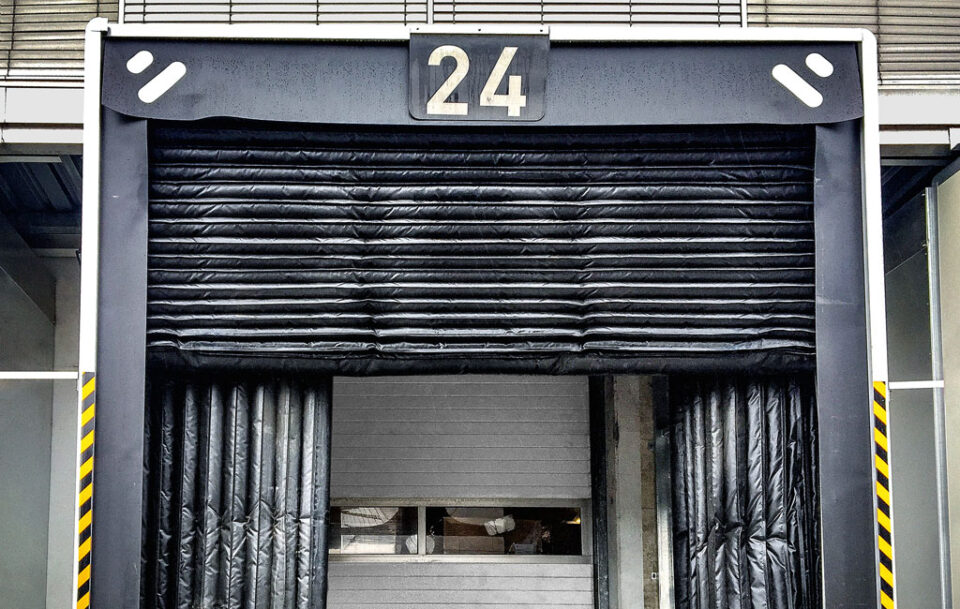Inflatable dock shelters are important for logistics companies. They close the gap between the docked truck and the warehouse, protecting the building interior from external environmental influences. Drafts, rain and wind, as well as insects and dust, stay outside. The desired interior temperature remains stable with neither heat nor cold escaping. Sealing off warehouses is fundamental, especially in sensitive areas such as the food industry. The inflatable dock shelter is activated at the push of a button. A fan fills cushions mounted at the top and sides with air within 20 seconds. The air pressure must remain constant during loading and unloading so that the cushions reliably seal the space between the dock and the truck.

In supermarkets, online shipping facilities, and distribution centers, dock shelters effectively — and now, thanks to RadiCal, also efficiently — protect against weather and temperature fluctuations. (Photo | Van Wijk)
This used to consume a lot of energy, especially when the loading process took longer. Erik Stoffer, Sourcing Manager at Dutch company Van Wijk, knows the problem. “The fan worked at full power during the entire loading process. Even when the cushions were completely inflated. It was really unnecessary.”

The RadiCal in scroll housing was a perfect fit for inflatable dock shelters. (Photo | ebm-papst)
Van Wijk is one of Europe’s leading manufacturers of dock levelers and dock shelters. The company manufactures and sells them under the brand name “Loading Systems.” Its customers are spread all over the world and include supermarket chains, furniture manufacturers, online shipping giants, and other large distribution centers. To meet its own quality standards, Van Wijk was looking for a partner to find a more energy-efficient solution for the inflatable dock shelters.
A fan on an energy-saving mission
That’s how the partnership with ebm-papst came about. They had just the right fan for the inflatable dock shelters: the RadiCal EC centrifugal fan in scroll housing. The fan was actually designed for residential ventilation, but ebm-papst recognized its potential to shine in other areas as well, as Archibald Bakker, sales engineer at ebm-papst Benelux, explains: “Since Van Wijk was looking for an energy-efficient solution for inflatable dock shelters, the RadiCal in scroll housing was a perfect fit.”
The fan shuts down the power as soon as the cushions are filled. The pressure remains constant.
Erik Stoffer, Sourcing Manager at Van Wijk
A vane anemometer is positioned in the fan’s scroll housing. This sensor measures the actual air flow and transmits the data to the fan’s integrated control electronics. The control electronics adjust the speed of the EC motor to the desired setpoint value, thus regulating the air volume. Erik Stoffer is enthusiastic about the new solution: “The fan shuts down the power as soon as the cushions are completely filled with air. The pressure in the cushions remains constant during the loading process even though the power is low.” The result: a 35 percent reduction in the application’s energy consumption. This not only reduces operating costs, but also protects the environment.

The RadiCal in a scroll housing was the perfect choice to create an energy-efficient solution. (Illustration | Timo Müller)
Onwards and upwards
But that’s not all. The inflatable dock shelters are set to become even more environmentally friendly in the future. Van Wijk sees a need to optimize the cushions, which are constructed from sturdy, wear-resistant PVC, by making them thinner. The advantages are obvious: “Thinner material means lower material consumption. This not only saves production costs, but is also more environmentally friendly,” says Stoffer. “We will then be leading the way not only in reducing our energy, but also our material consumption.”

Leave a comment